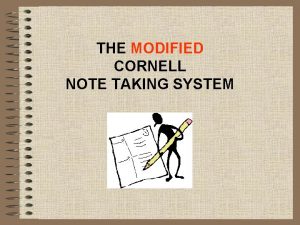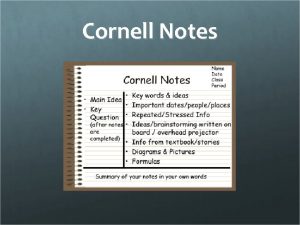Leadership and Cornell Notes Cornell Notes Divide your
















- Slides: 16

Leadership and Cornell Notes

Cornell Notes • Divide your page into two sections • The left side is for terms • And basic ideas • The right is for definitions, examples • And reactions

What makes a person want to follow a leader? • Turn and talk to a neighbor, then write together the qualities you come up with

To add… • People want to be guided by those they respect and who have a clear sense of direction. To gain respect, they must be ethical. A sense of direction is achieved by conveying a strong vision of the future.

Leadership • Leadership is a process by which a person influences others to accomplish an objective and directs the organization in a way that makes it more cohesive and coherent. • Northouse's (2007, p 3) definition: “Leadership is a process whereby an individual influences a group of individuals to achieve a common goal. ”

Be Know Do • The basis of good leadership is honorable character and selfless service to your organization. In your employees' eyes, your leadership is everything you do that effects the organization's objectives and their well-being. Respected leaders concentrate on (U. S. Army, 1983): • what they are [be] (such as beliefs and character) • what they know (such as job, tasks, and human nature) • what they do (such as implementing, motivating, and providing direction).

Principles of Leadership • To help you be, know, and do, follow these eleven principles of leadership (U. S. Army, 1983). Note that later chapters in this guide expand on these and provide tools for implementing them:

Principles • Know yourself and seek self-improvement - In order to know yourself, you have to understand your be, know, and do, attributes. Seeking self-improvement means continually strengthening your attributes. This can be accomplished through self-study, formal classes, reflection, and interacting with others. • • Be technically proficient - As a leader, you must know your job and have a solid familiarity with your employees' tasks.

Principles • Seek responsibility and take responsibility for your actions - Search for ways to guide your organization to new heights. And when things go wrong, they always do sooner or later — do not blame others. Analyze the situation, take corrective action, and move on to the next challenge. • Make sound and timely decisions - Use good problem solving, decision making, and planning tools.

Principles • Set the example - Be a good role model for your employees. They must not only hear what they are expected to do, but also see. We must become the change we want to see - Mahatma Gandhi • Know your people and look out for their well-being - Know human nature and the importance of sincerely caring for your workers. • Keep your workers informed - Know how to communicate with not only them, but also seniors and other key people.

Principles • Develop a sense of responsibility in your workers - Help to develop good character traits that will help them carry out their professional responsibilities. • Ensure that tasks are understood, supervised, and accomplished Communication is the key to this responsibility. • Train as a team - Although many so called leaders call their organization, department, section, etc. a team; they are not really teams. . . they are just a group of people doing their jobs. • Use the full capabilities of your organization - By developing a team spirit, you will be able to employ your organization, department, section, etc. to its fullest capabilities.

Attributes of Leadership • If you are a leader who can be trusted, then those around you will grow to respect you. To be such a leader, there is a Leadership Framework to guide you: • BE KNOW DO • • BE a professional. Examples: Be loyal to the organization, perform selfless service, take personal responsibility. • • BE a professional who possess good character traits. Examples: Honesty, competence, candor, commitment, integrity, courage, straightforwardness, imagination. •

• KNOW the four factors of leadership — follower, leader, communication, situation. • • KNOW yourself. Examples: strengths and weakness of your character, knowledge, and skills. • • KNOW human nature. Examples: Human needs, emotions, and how people respond to stress. • KNOW your job. Examples: be proficient and be able to train others in their tasks. • KNOW your organization. Examples: where to go for help, its climate and culture, who the unofficial leaders are.

• DO provide direction. Examples: goal setting, problem solving, decision making, planning. • • DO implement. Examples: communicating, coordinating, supervising, evaluating. • • DO motivate. Examples: develop morale and esprit de corps in the organization, train, coach, counsel.

The Process of Great Leadership • The road to great leadership (Kouzes & Posner, 1987) that is common to successful leaders: • • Challenge the process - First, find a process that you believe needs to be improved the most. • Inspire a shared vision - Next, share your vision in words that can be understood by your followers. • Enable others to act - Give them the tools and methods to solve the problem. • Model the way - When the process gets tough, get your hands dirty. A boss tells others what to do, a leader shows that it can be done. • Encourage the heart - Share the glory with your followers' hearts, while keeping the pains within your own.

Apply these qualities to your classes! • What happens to your classes if you practice these qualities every class period? • What happens to you?
 Cornell notes for anatomy and physiology
Cornell notes for anatomy and physiology Ions and ionic bonding cornell doodle notes
Ions and ionic bonding cornell doodle notes Transactional vs transformational leadership
Transactional vs transformational leadership Modified cornell notes
Modified cornell notes The interlopers summary
The interlopers summary What do cornell notes look like
What do cornell notes look like Cornell notes system
Cornell notes system Cornell notes example
Cornell notes example How does cornell notes work
How does cornell notes work Cornell notes advantages
Cornell notes advantages Cornell notes chemistry
Cornell notes chemistry Cornell notes setup
Cornell notes setup Walter pauk cornell
Walter pauk cornell Chemistry cornell notes
Chemistry cornell notes Cornell notes youtube
Cornell notes youtube Declaration of independence cornell notes
Declaration of independence cornell notes What do cornell notes look like
What do cornell notes look like




























